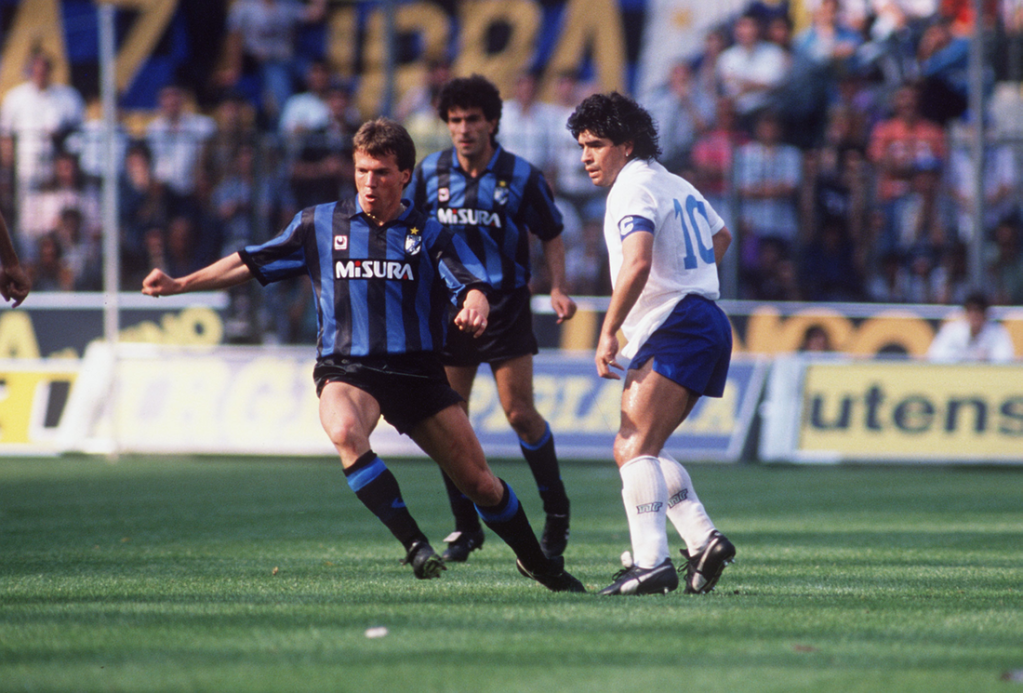“He is the best rival I’ve ever had; I guess that’s enough to define him”. High praise indeed from Diego Maradona, one of the greatest footballers to have ever played the game.
The rival he was referring to was Lothar Matthäus, whom Maradona had encountered during their Serie A days, as well as during the 1990 World Cup final, when the German man-marked Argentina’s golden boy.
Matthäus joined Inter for the start of the 1988-89 season along with fellow Bayern Munich team-mate Andreas Brehme. Prior to the start of that season, the Nerazzurri were in the midst of a barren spell. Eight years without a Scudetto win and seven years without any trophy, the natives were restless. Giovanni Trapattoni was the man entrusted in bringing success back to the San Siro and appeasing the fans, who longed for their club to give them something to celebrate.
Matthäus had an instant impact. Given the sacred no.10 shirt, he thrived. In the Bundesliga, he had been viewed as a dynamic and athletic midfielder, however the German was transformed in Serie A, becoming one of the league’s most creative players. In a league that was often maligned for being overly tactical and defensive, it was especially important for Serie A teams to possess that special game-changing player, a visionary that could see things others could not. Always keen to challenge himself, Matthäus adopted that role.
The Scudetto was won in his first season, the Nerazzurri finishing a comfortable 11 points above Maradona’s Napoli – a margin Inter would not replicate for another 16 years.
However, the following season brought little in the way of success. Unable to defend their Scudetto title, Inter also failed in the competition that proved to be Matthäus’s Achilles heel – the European Cup or Champions League as it became. Inter were knocked out in the first round, losing to Swedish side Malmo 2-1. Later in his career, whilst back at Bayern Munich, European glory would continue to evade the German after he suffered two final defeats against Porto and Manchester United.
On a personal and national level, 1990 proved to be his best season. Indeed, barring domestic European glory, he scooped up almost every award up for grabs. He was voted the Ballon d’Or winner, German footballer of the year, World Soccer Awards player of the year, named in the FIFA World Cup all-star team and of course, his crowning moment came when he captained his national side to a World Cup win in Rome’s Stadio Olimpico.
Matthäus returned to Milan resplendent in his personal triumphs. But not content, he pushed himself and Inter to more success during the 1990-91 campaign. A career high goals tally of 23, with 16 coming in Serie A, meant he was only just beaten to the Capocannoniere title by Gianluca Vialli. Meanwhile, Inter enjoyed success in European competition when they defeated Roma 2-1 over two legs in the UEFA Cup final. Matthäus was again instrumental, scoring from the penalty spot to earn the Milanese outfit their first European trophy for 26 years.
With Trapattoni back at Juventus, Matthäus endured a tough last season in Milan. New coach, Corrado Orrico, reverted to a defensive style of play which hardly suited Matthäus and the rest of the Inter squad. Consequently, at the end of the 1991-92 season, the Bavarian born midfielder returned home to re-join Bayern Munich.
Matthäus enjoyed much success back at Bayern but his most expansive and creative time was spent gracing pitches across Italy. Effervescent in the famous Nerrazzurri stripes, Matthäus’s performances were not only befitting of his no.10 jersey, they also ensured he became an Inter legend.

